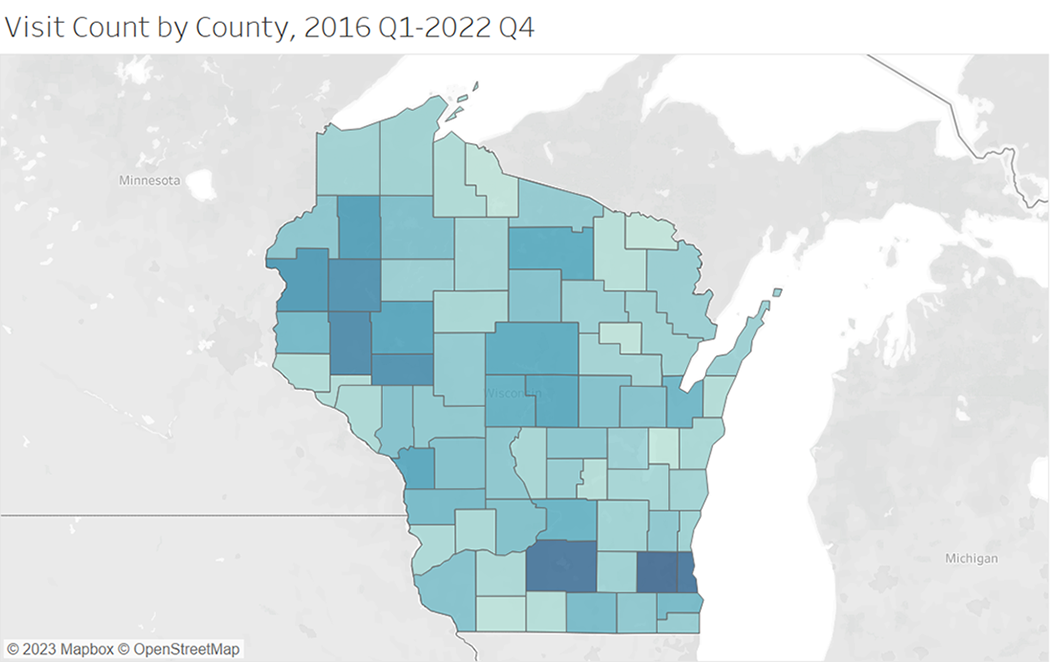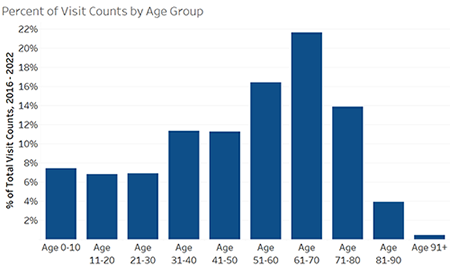Vol. 67, Issue 22
View more issues of The Valued Voice
Sign Up for WHA's Newsletter
Click here to view past issues
IN THIS ISSUE
- WHA Testifies in Support of Three More Bills to Expedite Health Care Licensure
- Wisconsin Hospitals State PAC and Conduit Fundraising Nears Halfway Mark
- Have You Utilized This Member Benefit Yet? WHA Speaker Bureau
- Fast Facts from the WHA Information Center: Lyme Disease
- Annual Wisconsin Organization of Nurse Leaders (WONL) Conference Announced
EDUCATION EVENTS
May. 13, 2025
Governing Body and Medical Staff Conditions of ParticipationMay. 13, 2025
Critical Access Hospital (CAH) Conditions of Participation SeriesMay. 14, 2025
2025 WHA Workforce ForumClick here to view education event calendar
View more issues of The Valued Voice
Sign Up for WHA's Newsletter
Thursday, June 1, 2023
Fast Facts from the WHA Information Center: Lyme Disease
With summer right around the corner, residents will be taking advantage of the great outdoors. While the summertime in Wisconsin is one of the best times of year, there are certain diseases to be on the lookout for that mainly occur during the summer. Lyme disease, a tick-borne infection, is one of the diseases to be cautious about in both humans and pets.
The Centers for Disease Control and Prevention (CDC) states that every year, approximately 30,000 cases of Lyme disease are reported. The CDC wrote in recent studies, however, that they believe the number diagnosed is closer to 476,000 cases. Lyme disease is caused by the borrelia bacteria, which can be found throughout most of the United States. Lyme disease is most common in the upper Midwest and the northeastern and mid-Atlantic states. Ticks often live in grassy, wooden, or brushy areas.



The WHA Information Center analyzed claims for Lyme disease in Wisconsin to see how our state hospital data looks compared to national trends. When looking at the map of visit counts by county, there is a group of counties in northwest Wisconsin that have higher counts than other areas. The average age of a patient being seen in a hospital for Lyme disease is 49 years of age. The age group that sees the highest number of visits for Lyme disease is ages 61-70. When looking at gender by visit count, men have a slightly higher visit count than women. The number of visits when broken down by quarter shows a very large increase in visits for the months of July through September (peak summer months).


The following are tips from Mayo Clinic to help prevent tick bites that may cause Lyme Disease:
Use tick repellent:
The Centers for Disease Control and Prevention (CDC) states that every year, approximately 30,000 cases of Lyme disease are reported. The CDC wrote in recent studies, however, that they believe the number diagnosed is closer to 476,000 cases. Lyme disease is caused by the borrelia bacteria, which can be found throughout most of the United States. Lyme disease is most common in the upper Midwest and the northeastern and mid-Atlantic states. Ticks often live in grassy, wooden, or brushy areas.



The WHA Information Center analyzed claims for Lyme disease in Wisconsin to see how our state hospital data looks compared to national trends. When looking at the map of visit counts by county, there is a group of counties in northwest Wisconsin that have higher counts than other areas. The average age of a patient being seen in a hospital for Lyme disease is 49 years of age. The age group that sees the highest number of visits for Lyme disease is ages 61-70. When looking at gender by visit count, men have a slightly higher visit count than women. The number of visits when broken down by quarter shows a very large increase in visits for the months of July through September (peak summer months).


The following are tips from Mayo Clinic to help prevent tick bites that may cause Lyme Disease:
Use tick repellent:
- Spray your outdoor clothing, shoes, tent, and other camping gear with a repellent that has 0.5% permethrin. Some gear and clothing may be pre-treated with permethrin.
- Use an insect repellent registered with the Environmental Protection Agency on any exposed skin, except your face. These include repellents that contain DEET, picaridin, IR3535, oil of lemon eucalyptus (OLE), para-menthane-diol (PMD) or 2-undecanone.
- Wear light-colored clothing that makes it easier for you or others to see ticks on your clothing.
- Avoid open-toed shoes or sandals.
- Wear long-sleeved shirts tucked into your pants.
- Wear long pants tucked into your socks.
- Shower as soon as possible to wash off any loose ticks. Check for ticks that may have burrowed.
- Check your gear. Before you wash your outdoor clothes, put them in the dryer on hot for at least 10 minutes to kill ticks.
- Do a daily inspection for ticks on any pet that spends time outdoors.
- Stay on clear paths as much as possible in wooded and grassy areas.
Vol. 67, Issue 22
Thursday, June 1, 2023
Fast Facts from the WHA Information Center: Lyme Disease
With summer right around the corner, residents will be taking advantage of the great outdoors. While the summertime in Wisconsin is one of the best times of year, there are certain diseases to be on the lookout for that mainly occur during the summer. Lyme disease, a tick-borne infection, is one of the diseases to be cautious about in both humans and pets.
The Centers for Disease Control and Prevention (CDC) states that every year, approximately 30,000 cases of Lyme disease are reported. The CDC wrote in recent studies, however, that they believe the number diagnosed is closer to 476,000 cases. Lyme disease is caused by the borrelia bacteria, which can be found throughout most of the United States. Lyme disease is most common in the upper Midwest and the northeastern and mid-Atlantic states. Ticks often live in grassy, wooden, or brushy areas.



The WHA Information Center analyzed claims for Lyme disease in Wisconsin to see how our state hospital data looks compared to national trends. When looking at the map of visit counts by county, there is a group of counties in northwest Wisconsin that have higher counts than other areas. The average age of a patient being seen in a hospital for Lyme disease is 49 years of age. The age group that sees the highest number of visits for Lyme disease is ages 61-70. When looking at gender by visit count, men have a slightly higher visit count than women. The number of visits when broken down by quarter shows a very large increase in visits for the months of July through September (peak summer months).


The following are tips from Mayo Clinic to help prevent tick bites that may cause Lyme Disease:
Use tick repellent:
The Centers for Disease Control and Prevention (CDC) states that every year, approximately 30,000 cases of Lyme disease are reported. The CDC wrote in recent studies, however, that they believe the number diagnosed is closer to 476,000 cases. Lyme disease is caused by the borrelia bacteria, which can be found throughout most of the United States. Lyme disease is most common in the upper Midwest and the northeastern and mid-Atlantic states. Ticks often live in grassy, wooden, or brushy areas.



The WHA Information Center analyzed claims for Lyme disease in Wisconsin to see how our state hospital data looks compared to national trends. When looking at the map of visit counts by county, there is a group of counties in northwest Wisconsin that have higher counts than other areas. The average age of a patient being seen in a hospital for Lyme disease is 49 years of age. The age group that sees the highest number of visits for Lyme disease is ages 61-70. When looking at gender by visit count, men have a slightly higher visit count than women. The number of visits when broken down by quarter shows a very large increase in visits for the months of July through September (peak summer months).


The following are tips from Mayo Clinic to help prevent tick bites that may cause Lyme Disease:
Use tick repellent:
- Spray your outdoor clothing, shoes, tent, and other camping gear with a repellent that has 0.5% permethrin. Some gear and clothing may be pre-treated with permethrin.
- Use an insect repellent registered with the Environmental Protection Agency on any exposed skin, except your face. These include repellents that contain DEET, picaridin, IR3535, oil of lemon eucalyptus (OLE), para-menthane-diol (PMD) or 2-undecanone.
- Wear light-colored clothing that makes it easier for you or others to see ticks on your clothing.
- Avoid open-toed shoes or sandals.
- Wear long-sleeved shirts tucked into your pants.
- Wear long pants tucked into your socks.
- Shower as soon as possible to wash off any loose ticks. Check for ticks that may have burrowed.
- Check your gear. Before you wash your outdoor clothes, put them in the dryer on hot for at least 10 minutes to kill ticks.
- Do a daily inspection for ticks on any pet that spends time outdoors.
- Stay on clear paths as much as possible in wooded and grassy areas.
IN THIS ISSUE
- WHA Testifies in Support of Three More Bills to Expedite Health Care Licensure
- Wisconsin Hospitals State PAC and Conduit Fundraising Nears Halfway Mark
- Have You Utilized This Member Benefit Yet? WHA Speaker Bureau
- Fast Facts from the WHA Information Center: Lyme Disease
- Annual Wisconsin Organization of Nurse Leaders (WONL) Conference Announced

